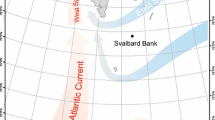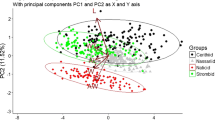Abstract
To address the question of hermit crab clustering, 11 clumps composed of Clibanarius laevimanus were studied in the mangal of Mida Creek, Kenya in 1988. Hermit size and sex were analyzed, as well as the type, dimensions, and status of their shells. Empty gastropod shells constituted a limiting factor on the population studied; the architectural traits which seemed to be favored by the hermits were those associated with a defence against crab predators (high weight and narrow apertures). Differences in either the availability of adequate shells or in the services provided by the housing in question explained the observed diversity in both the type and the mass of shells occupied among the examined population categories. Furthermore, each clump showed homogeneity with respect to the dimensions of the hermits participating in it, and immature and adult specimens were partitioned among three cluster types. It is suggested that clustering might be classified as a social phenomenon, becaus hermits are attracted by similarly sized conspecifics, interact through an elaborate communication system, and because most benefit from a chain process in shell exchange.
Similar content being viewed by others
References
Abrams PA (1988) Sexual difference in resource use in hermit crabs; consequences and causes. In: Chelazzi G, Vannini M (eds) Behavioral adaptation to the intertidal life. Plenum Press, New York, pp 283–296
Bertness MD (1981 a) Conflicting advantages in resource utilization: the hermit crab housing dilemma. Am Nat 118:432–437
Bertness MD (1981 b) Predation, physical stress, and the organization of a tropical hermit crab community. Ecology 62:411–425
Bertness MD (1981 c) The influence of shell-type on hermit crab growth rate and clutch size (Decapoda, Anomura). Crustaceana 40:197–205
Bertness MD (1981 d) Interference, exploitation, and sexual components of competition in a tropical hermit crab assemblage. J exp mar Biol Ecol 49:189–202
Bertness MD (1981 e) Competitive dynamics of a tropical hermit crab assemblage. Ecology 62:751–761
Bertness MD (1982) Shell utilization, predation pressure, and thermal stress in Panamianan hermit crabs: an interoceanic comparison. J exp mar Biol Ecol 64:159–187
Borjesson DL, Szelistowski WA (1989) Shell selection, utilization and predation in the hermit crab Clibanarius panamensis Stimpson in a tropical mangrove estuary. J exp mar Biol Ecol 133:213–228
Chase ID, Weissburg M, Dewitt TH (1988) The vacancy chain process: a new mechanism of resource distribution in animals with application to hermit crabs. Anim Behav 36:1265–1274
Childress JR (1972) Behavioral ecology and fitness theory in a tropical hermit crab. Ecology 57:960–964
Conover MR (1978) The importance of various shell characteristics to the shell-selection behaviour of hermit crabs. J exp mar Biol Ecol 32:131–142
Drapkin EI (1963) Effect of Rapana bezear Linné (Mollusca Muritidae) on the Black Sea fauna. Dokl Akad Nauk SSSR 151:700–703. (Translation, Biol Sci Sect 151:964–966)
Fotheringham N (1976) Hermit crab shells as a limiting resource (Decapoda: Paguridea). Crustaceana 31:194–197
Fotheringham N (1980) Effects of shell utilization on reproductive patterns in tropical hermit crab. Mar Biol 55:287–293
Gherardi F (1990) Competition and coexistence in two Mediterranean hermit crabs, Calcinus ornatus (Roux) and Clibanarius erythropus (Latreille) (Decapoda, Anomura). J exp mar Biol Ecol 143:221–238
Gherardi F (1991) Relative growth, population structure, and shellutilization of the hermit crab Clibanarius erythropus in the Mediterranean. Oebalia (Taranto, Italy) 17:181–196
Gherardi F, Micheli F, Vannini M (1989) Movement patterns and dispersal of the hermit crab Clibanarius longitarsus in a mangrove swamp. Mar Behav Physiol 16:209–223
Gherardi F, Micheli F, Vannini M (1991) Preliminary observations of the clustering behaviour of the tropical hermit crab, Clibanarius laevimanus. Ethol Ecol Evoln (Spec Issue) 1:151–153
Gherardi F, Vannini M (1992) Hermit crabs in a mangrove swamp: clustering dynamics in Clibanarius laevimanus. Mar Behav Physiol 21:85–104
Gherardi F, Vannini M (1993) Hermit crabs in a mangrove swamp proximate and ultimate factors in the clustering of Clibanarius laevimanus. J exp mar Biol Ecol 168:167–187
Haas F (1950) Hermit crabs in fossil snail shells in Bermuda. Ecology 31:152
Hazlett BA (1970) Interspecific shell fighting in three sympatric species of hermit crabs in Hawaii. Pacif Sci 24:472–482
Hazlett BA (1978) Shell-exchanges in hermit crabs: aggression, negotiation or both? Anim Behav 26:1278–1279
Hazlett BA (1980) Communication and mutual resource exchange in North Florida hermit crabs. Behavl Ecol Sociobiol 6:177–184
Kellogg CW (1976) Gastropod shells: a potentially limiting resource for hermit crabs. J exp mar Biol Ecol 22:101–111
Kuris AM, Brody MS (1976) Use of principal component analysis to describe the snail shell resource for hermit crabs. J exp mar Biol Ecol 22:69–77
MacGinitie GE (1955) Distribution and ecology of the marine invertebrates of Point Barrow, Alaska. Smithson misc Collns 128:1–201
Markham JC (1968) Notes on growth-pattern and shell-utilization of the hermit crab Pagurus bernhardus (L.). Ophelia 5:189–205
Miller RS (1967) Pattern and process in competition. Adv ecol Res 4:1–74
Provenzano AJ Jr (1960) Notes on Bermuda hermit crabs (Crustacea: Anomura). Bull mar Sci Gulf Caribb 10:117–124
Reese ES (1969) Behavioral adaptations of intertidal hermit crabs. Am Zool 9:343–355
Samuelson TJ (1970) The biology of six species of Anomura (Crustacea, Decapoda) from Raunefjorden, Westen Norway. Sarsia 45:25–42
Seal H (1964) Multivariate statistical analysis for biologists. Methuen, London
Siegel S (1956) Nonparametric statistics for the behavioral sciences. McGraw-Hill, New York
Snyder-Conn E (1981) The adaptive significance of clustering in the hermit crab Clibanarius digueti. Mar Behav Physiol 8:43–53
Spight T (1977) Availability and use of shells by intertidal hermit crabs. Biol Bull mar biol Lab, Woods Hole 152:120–133
Thompson MT (1903) The metamorphoses of hermit crabs. Proc Boston Soc nat Hist 31:147–209
Vance RR (1972) Competition and mechanisms of coexistence in three sympatric species of intertidal hermit crabs. Ecology 53:1062–1074
Walters WL, Griffiths CL (1987) Patterns of distribution, abundance and shell utilization amongst hermit crabs, Diogenes brevirostris S Afr J Zool 22:269–277
Wilber TP (1989) Associations between gastropod shell characteristics and egg production in the hermit crab Pagurus longicarpus. Oecology 81:6–15
Wilber TP (1990) Influence of size, species and damage on shell selection by the hermit crab Pagurus longicarpus. Mar Biol 104:31–39
Wilson EO (1975) Sociobiology. Harvard University Press, Cambridge
Zar JH (1984) Biostatistical analysis. Prentice-Hall, Englewood Cliffs, NJ
Author information
Authors and Affiliations
Additional information
Communicated by M. Sarà, Genova
Rights and permissions
About this article
Cite this article
Gherardi, F., Zatteri, F. & Vannini, M. Hermit crabsin a mangrove swamp: the structure of Clibanarius laevimanus clusters. Marine Biology 121, 41–52 (1994). https://doi.org/10.1007/BF00349472
Received:
Accepted:
Issue Date:
DOI: https://doi.org/10.1007/BF00349472




